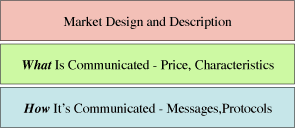OASIS Energy Market Information Exchange
Technical Committee
—EMIX—
The OASIS Energy Market Information Exchange Technical Committee (EMIX) has defined standardized communication of price and product information; it does not address market design or operations or interoperation protocols.
The OASIS Energy Market Information Exchange Technical Committee grew out of work that started before the GridEcon conference in March 2009, and has been widely discussed and disseminated. The TC addresses the key issue of interoperable price communication—not the determination of what a price is, rather how to communicate prices—along with a description of what is being bought or sold.
As with all OASIS work, everything from group emails to meeting minutes to drafts to final standards will be available on the web as soon as it's produced. See the EMIX TC web page for details and standards produced as well as a series of Technical Notes on applications.
Motivation
There are hundreds of ways today to communicate price information. But you don't buy something just on price—you buy based on value, so you want to know something about what you're buying, for example environmental characteristics. An interoperable way to exchange energy price and information is a top priority for the NIST Smart Grid plans, and will help people meet their needs and enable new business opportunities.
A price needs context; it's not just a number. The context includes the market rules, which can be very complex, and things such as location, currency, and time for availability. Here's a graphic that William Cox presented at GridEcon in March 2009 (from the full slides for Smart Grid Economic Interfaces).

This graphic shows the context and use of a price. In market transactions there are three aspects:
-
The design and description of the market in which the transaction takes place
-
What is communicated, for example the price and characteristics of the energy such as source, carbon characteristics, the time interval in which the price applies, quantity and units.
-
How the information is communicated, the messages and protocols.
EMIX tries to communicate the middle layer; it is not a protocol, message definition, and it certainly is not a description of market design and rules. The OASIS Energy Interoperation Technical Committee addresses how and what for demand response and distributed energy resource signals, and includes message payloads (what is communicated) and the interoperation sequence using web services (how the information, including prices, is communicated).
The goal is to allow buildings, industrial facilities, homes and appliances, vehicles and more to exchange actionable information with markets, utilities, and aggregators to improve the energy and environmental response of facilities and the smart grid. And to work well with each of the endpoints.
This TC will not address how price information is communicated. This allows great flexibility to use the specification in many ways, for instance as part of a price signal in the Energy Interoperation protocol.
Support for This Technical Committee
The full charter, list of supporters, and Call for Participation includes 44 individuals and their companies that support the creation of the EMIX TC. They include stakeholders from utilities (Consumers Energy and the Electric Power Research Institute), system integrators and software experts, building and facility automation, building managers such as the United States General Services Administration, the Open Geospatial Consortium, and many more.
The convener is Edward Cazalet of The Cazalet Group. Ed has been on the Board of Governors of the California Independent System Operator, and is an expert in energy markets. He is CEO of TEMIX, a company devoted to Transactive Energy Market Information Exchanges.
Last updated: 11 November 2014
